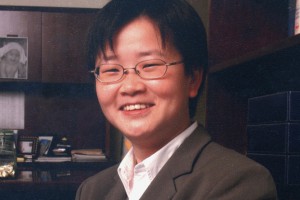Researchers from the University of Glasgow claim to have found a way to make swallowable cameras which can be used for detecting cancers of the throat and gut. Tiny sensing systems small enough for patients to swallow have been used by doctors but these devices have relied on additional illumination with a separate light source and have been restricted to ...
Device R&D
Optical transistor will be faster than CMOS devices
Researchers in the US have demonstrated what is in effect an ‘optical transistor’ which can modulate light, as in optical fibre communications, at terahertz frequencies. The team at Purdue University claim that the so-called “plasmonic oxide material” could make possible devices for optical communications that are at least 10 times faster than conventional technologies. The optical material made of aluminum-doped ...
University embeds RFID chips in yarn
Researchers at Nottingham Trent University have come up with a way of embedding RFID chips in yarns which can then be woven or knitted to make fabrics for clothing. Professor Tilak Dias of the Advanced Textiles Research Group of the School of Art & Design, claims that the embedded chips “cannot be seen in situ by the naked eye”. He has patented ...
Wearable tech will revolutionise healthcare, says Imperial
Scientists from The Hamlyn Centre, Imperial College London, are presenting their latest research in wearable tech at the Royal Society’s annual Summer Science Exhibition, which officially opens to the public today. The theme for the Hamlyn Centre’s exhibit is “smart sensing”, technologies for wearables devices. It will include very low power ICs and sensors, ranging from optical, impedance, and micro-fluidics. Professor Guang-Zhong ...
D-Wave puts 1,000 qubits on a chip
D-Wave Systems has put 1,000 qubits, comprising 128,000 Josephson Junctions, on a chip using a six-metal layer planar process with 0.25μm features, the company reports. D-Wave’s quantum computer runs a quantum annealing algorithm to find the lowest points, corresponding to optimal or near optimal solutions, in a virtual “energy landscape.” Every additional qubit doubles the search space of the processor. ...
Major robot research network launched in UK
Robotics research in the UK has been given a major boost with the launch of an EPSRC-funded UK Robotics and Autonomous Systems Network (UK-RAS Network). The aim of the network is to bring together robotics R&D activities in UK universities and to set up industry collaborations that hopefully will result in commercial products. Behind the a high-profile launch at the Science ...
ITF2015: Imec’s super-smart T-shirt
Today, at the Imec Technology Forum, Imec and Holst Centre are demonstrating what they describe as the most advanced smart garment to date. The smart T-shirt measures a highly accurate electrocardiogram (ECG), recognises activity and calculates energy expenditure in an unobtrusive way, according to Imec. “Smart garments have the ability to tackle a vast range of applications from fitness tracking ...
Powi-Fi enables IoT
Energy scavenging has found a new source of of power – ambient Wi-Fi signals. A PhD student at Washington University in Seattle, Vamsi Talla, scavenged energy from Wi-Fi signals and used it to power a temperature sensor. When stored in a capacitor the power was sufficient to allow a surveillance camera to take a picture every 35 minutes. For the ...
Nanotech researchers come to Birmingham event
Nanotech researchers from around the world will gather at Birmingham City University’s City Centre Campus next month for a two-day conference. Called “Advances in nanotechnology 2015“, the conference and workshops will discuss the manipulation of matter on an atomic, molecular, and supramolecular scale in medicine and healthcare, nanomechanics and industrial applications of graphene. Speakers at the event on June 9th ...
Plastic electronics firm partners with Merck on bendable display
FlexEnable has partnered with organic electronic materials supplier Merck to bring plastic LCDs to market. The firms have developed a plastic LCD which is free of glass and uses organic transistors on a plastic sheet. FlexEnable claims this is the first plastic LCD with active-matrix in-plane switching (IPS). It uses the Cambridge-based firm’s OTFT array as well as liquid crystal ...
 Electronics Weekly Electronics Design & Components Tech News
Electronics Weekly Electronics Design & Components Tech News









